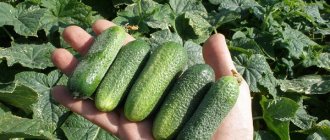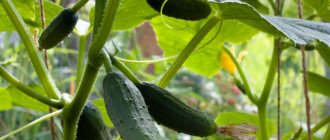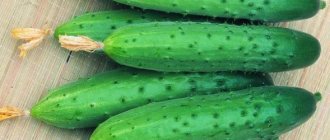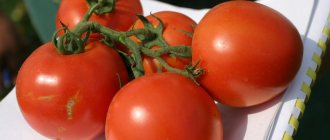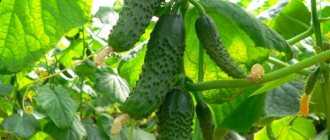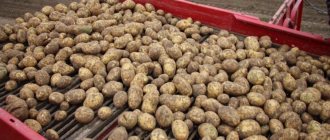Cucumber Mashenka F1 is one of the universal, reliable hybrids that will provide the gardener with both winter preparations and summer salads. It is easy to grow, you don’t have to worry about diseases, and the taste of the fruit exceeds all expectations.
| Landing location | Ripening time | Mode of application | Fruit length | Group | Fruit smoothness | Pollination method |
| Universal | Early ripening (35-45 days) | Universal | Short (gherkins) - less than 10 cm | Hybrid | Slightly lumpy | Parthenocarpic |
Description of the variety
The early ripening hybrid “Mashenka f1” is self-pollinating and is intended for fresh consumption; it is also in demand for canning and pickling. Its taste and marketability are very high. The hybrid is disease-resistant and is practically not affected by powdery mildew, as well as the cucumber mosaic virus.
The plant has bright green leaves, average climbing ability, and six-seven-fruited ovaries. The period from germination to the stage of mass fruiting takes about 37 days. The average yield is at least 10.5 kg per square meter of plantings. The harvest is long: from June to early October.
Zelentsy have a cylindrical, leveled shape. The average length of greens can vary from 8 cm to 11 cm. The average weight of one greens is from 80 g to 100 g. The pulp has a pronounced cucumber aroma, is not bitter, crispy, very tasty, with medium-sized seeds.
Harvest and storage
You can start harvesting when the fruit reaches 8 cm in size. You should not wait for the cucumber to grow to 10-11 cm, as in this case the peel becomes thicker.
If the seedling cultivation method is used, then the harvest period can be considered 37-40 days after the emergence of seedlings. When the seed is immersed in open ground, the ripening time increases by 2-3 weeks.
It is recommended to store the vegetable in the refrigerator for no more than 28-30 days. Can be used for salads, canning, pickling.
Advantages and disadvantages
The main advantage of this hybrid form is its high yield. In addition, the Mashenka f1 cucumber has the following advantages:
- excellent taste characteristics, lack of bitterness;
- the fruits are even in shape and have small spines;
- parthenocarpic plant;
- obtaining a very early harvest;
- suitability for cultivation in open and protected ground;
- high resistance to the most common diseases;
- versatility of use.
The hybrid “Mashenka f1” has practically no disadvantages and, if agricultural technology is followed, shows high survival rate, excellent rates of development and fruiting.
Video review of the Masha variety
This video talks about the features of Masha cucumbers, what they look like, why they are remarkable, and how to care for them:
The cucumber variety Masha enjoys well-deserved attention among all gardeners and farmers. It is characterized by high yield, excellent storage and transportability. But for this you need to follow simple rules of planting, growing, care and collection. This is an indispensable vegetable at any time of the year.
0
0
Copy link
Landing rules
Cucumbers of the hybrid form “Mashenka f1” can be grown both by seedlings and without seedlings, by direct sowing of seeds on beds. Seeds show excellent and consistent germination when sown with or without pre-soaking.
When cultivating in regions with insufficiently warm spring and short summer periods, it is recommended to plant cucumbers using seedlings. For this purpose, it is necessary to carry out pre-sowing treatment of the purchased seed material in a solution of potassium permanganate, followed by soaking in clean water until the seeds begin to hatch.
Sowing in the last days of May is carried out in separate planting containers, which are filled with soil mixture. The composition of such a mixture should include two parts of garden soil, six parts of high-quality humus and one part of rotted manure. The prepared soil should be spilled with boiling water for disinfection.
Caring for the plants that appear after a week is standard. It is necessary to water and maintain optimal temperature conditions for growth and development, as well as humidity levels in the room for growing cucumber seedlings. It is very important to protect seedlings from drafts and shading.
A week before transplanting, 20-day-old seedlings should be hardened off. Planting should be done after the likelihood of return frosts has passed. When replanting, it is necessary to preserve the earthen ball around the root system as much as possible. If the weather is sunny and too hot, then in the first three days the planted plants are shaded.
When sowing seeds directly into the ground, it is recommended to cover the ridges with plastic film, which will help retain heat and speed up the emergence of seedlings. Sowing is carried out exclusively in heated and well-moistened soil to a depth of no more than 2.5-3.5 cm. It is necessary to sow seeds under the film after the threat of frost, when the soil warms up to 10-12°C. Plant development and productivity will depend on further adherence to agricultural technology.
Outlander Masha is our joy
Depending on the region of cultivation, Masha F1 can grow in open beds, under film cover, and in greenhouses of various types.
Cucumbers of the Masha F1 variety are determinant
Cucumber of this variety is a determinate plant, that is, with a natural limitation on the height of development of the main stem. It is medium-sized and has a low ability to form shoots, which significantly reduces labor costs for formation.
An important feature of this variety is that it belongs to the group of parthenocarpic cucumbers, that is, those that do not require pollination by insects. Its flowers are of the female type, the vast majority of them form ovaries.
The State Register notes that the Masha F1 variety is an early-ripening cucumber. There is information on the network that the first harvest of these vegetables can be harvested within 36 days after seed germination.
Almost all fruits are equal in size: they reach a length of 8.5–9 cm, a thickness of 3–3.5 cm and a weight of about 90 g. During variety testing, Masha F1 cucumbers grown in a film greenhouse produced 10–11 kg of marketable fruits per 1 m2 .
The fruits are intended for fresh consumption as salad fruits. The State Register recommends their use for canning. These cucumbers are not bitter. Canned fruits remain dense, crispy, elastic, and have no voids. The taste in both types of use during variety testing received ratings of “good” and “excellent” from tasters.
Harvested Masha F1 cucumbers can easily be transported over long distances. The variety perfectly resists:
- powdery mildew;
- cucumber mosaic;
- olive spot.
Features of care
“Mashenka f1” cucumbers should be grown at a planting density of three plants per square meter in the vertical cultivation method, and no more than five plants in the horizontal method. Basic measures for caring for cucumbers are recommended to be carried out early in the morning or in the evening, after sunset:
- abundant watering with warm water - every other day, and if the weather is too hot, it is better to irrigate daily;
- fertilizing three times a month using slurry or urea solution at the rate of 10 g per bucket of water;
- systematic removal of weeds followed by shallow loosening of the soil around the plants;
- tying cucumber vines makes it much easier to care for plants and makes the ripening process more complete;
- preventive spraying of plants with folk remedies, including infusions of tomato tops and onions.
Harvesting occurs as the greens ripen. It is very important to prevent fruit from overgrowing, which can cause significant depletion of the plant and negatively affect fruiting.
Diseases and pests
In general, Maria f1 cucumber is highly resistant to common viral diseases of this crop. However, the variety is quite vulnerable to changes in temperature and humidity levels - these factors can provoke the development of fungal diseases.
Root rot
The weak roots of the Maria hybrid easily rot if exposed to excess moisture with cold water. You can learn about the development of rot by brown cankers on the root part of the variety’s stem. To save the cucumber, when the first planting marks form, they are treated with Fitosporin, or a solution of tar soap with iodine.
Cladosporiosis
The disease manifests itself as greenish-brown watery marks on the leaves of the variety. At the same time, the cucumber curls and dries. The disease is provoked by high humidity and temperature changes. At the first signs of cladosporiosis, Maria f1 bushes are treated with copper oxychloride, or a copper-chalk solution. Severely affected shoots are cut off and burned.
Whitefly
A small white butterfly often attacks cucumbers in stuffy, waterlogged greenhouses. If whitish larvae and sticky mucus appear on the leaves of the variety, it means that the bushes have been colonized by whiteflies. You can rid Maria plants of the pest using a strong tincture of garlic, or whey with the addition of regular laundry soap. For prevention, greenhouses are ventilated every day and weeds are pulled out completely.
How to care for cucumbers (video)
It is this hybrid that is most often grown by vegetable growers who are engaged in mini-farming and grow vegetable products all year round for the purpose of sale. Despite the regular appearance of new products on the seed market, most vegetable growers are in no hurry to replace the Mashenka hybrid with them. Cucumber seeds called “Mashenka F1” guarantee a good and high yield, even cucumbers of equal size, as well as a complete absence of barren flowers, which is important in the absence of pollinating insects.
Pros and cons of the variety
Despite her youth, Mashenka f1 is rapidly winning the sympathy of gardeners. Based on the descriptions, vegetable growers are attracted by its endurance, relative unpretentiousness with good yield and quality of fruits. The cucumber does not exhibit any disadvantages that are significant for cultivation and sales.
pros
Mashenka f1 can boast many of the most valuable advantages for a gardener
First of all, the following advantages of the variety attract attention:
- stress resistance - cucumber can ripen even in the harsh Siberian climate, it does not suffer too much from slight drops in temperature and droughts;
- productivity - despite its precociousness, the cucumber is capable of producing a yield of up to 15.6 kg/m² - this is almost 1.5 times more than the Dutch hybrid Masha;
- high immunity - the vegetable is practically not susceptible to infection with cucumber mosaic and powdery mildew;
- excellent taste - judging by the description, Mashenka has a pleasant sweetish taste, juiciness and a pronounced crunch
Mis-grading is very rare in the variety harvest; all the greens are aligned, dense, bright and attract the attention of buyers well.
Minuses
The negative aspects of Mashenka f1 do not make its cultivation too difficult. However, they should definitely be taken into account during the growing process:
- cucumber quickly outgrows - you need to harvest every day, preferably at the gherkin stage;
- The peel of the variety is quite dense - for salad it is better to peel it off to avoid a bitter taste in the dish.
Otherwise, Mashenka is an excellent, undemanding vegetable that even an inexperienced farmer can grow.
Recommendations for cultivation
This hybrid variety of cucumbers is perfect for growing both in a greenhouse and in the garden. To get a large harvest, you need to pay close attention to the composition of the soil. It should be fertile and light. The acidity level should not be high. A neutral level would be ideal. To increase soil fertility, it is recommended to fertilize the cucumber bed in the fall with any available organic matter.
Advice! The use of compost and mullein gives good results in soil enrichment. Growing and incorporating green manure into it will help make the soil lighter.
If cucumbers of the Masha F1 variety are grown in a greenhouse, it is recommended to disinfect the soil before planting. The following drugs are suitable for this:
- bleaching powder;
- copper sulfate;
- fungicide TMTD;
- phytosporin;
- trichodermin;
- and others.
Important! All these drugs should be used only as directed. Exceeding the standards established by the manufacturer is not allowed.
You should not grow cucumbers of the Masha variety where representatives of the pumpkin family grew before them. This will significantly reduce their productivity.
Cucumber Masha can be grown in two ways:
- Through seedlings, which begin to be prepared in April. In this case, it is better to plant each cucumber seed in a separate container. The optimal temperature for growing seedlings will be 25 degrees. But it must be reduced to 20 degrees a week before landing in a new place. If this is not done, cucumber seedlings may die from too sudden a change in temperature. Ready seedlings are planted in a greenhouse or garden bed in May, only after they have 4 true leaves.
- Planting seeds at the end of May. At the same time, cucumber seeds of the Masha F1 variety should not be buried more than 3 cm into the soil. After planting, it is recommended to cover the seeds with film.
Important! Masha cucumber seeds are treated with a special nutritional composition. Therefore, they should not be pre-soaked.
Both seeds and seedlings of Masha cucumbers should be planted according to a 50x30 cm pattern, that is, no more than 4 plants per square meter.
Subsequent care for the plants of this hybrid is quite simple:
- Watering - the yield directly depends on its regularity. Typically, you should water cucumbers no more than twice a week. But when dry weather sets in, watering should be done every day.
- Weeding – given the shallow root system of these plants, weeding should be done very carefully.
- Hilling up - no more than twice a season.
- Fertilization - it must be carried out throughout the season. The first time, you need to fertilize young plants with the first two leaves. The second time and subsequent times - every two weeks. A mixture of a liter of manure and 10 liters of water shows good results. When adding ash to this mixture, the cucumbers will begin to actively grow.
Important! If chemical or mineral agents are used as fertilizer, their overdose is unacceptable. Cucumbers stuffed with such fertilizers can be harmful to health.
In addition, to stimulate the formation of side shoots of this hybrid variety, it is recommended to pinch the shoots above the fifth leaf. You also need to ensure that the number of cucumbers on a branch is not more than 15. If there are any extra ones, they must be removed without sparing.
If cucumbers are grown in a greenhouse or greenhouse, then ventilation must be done.
Diseases and pests
Although the variety is resistant to many typical cucumber diseases, under unfavorable conditions the plant can be affected by anthracnose, white rot and other ailments.
Table: diseases of the hybrid Masha F1
| Diseases | Signs of manifestation | Prevention | Control measures |
| Cucumber mosaic | leaves and fruits become mottled and deformed |
| Treatment with Fundazol no later than 10 days before the start of cucumber harvesting according to the instructions for the drug. |
| Anthracnose | White or light yellow spots appear on the leaves |
| Treatment with Hom or Ridomil-Gold according to the instructions for them. |
| Downy mildew | brown spots appear on the leaves, which later turn into a fluffy coating | sprinkling leaves with crushed wood ash | Treatment with Fundazol (according to instructions). |
| White rot | a white fluffy coating forms on the affected parts of the plant, including fruits | sheltering bushes when cold weather sets in in summer |
|
Diseases of the hybrid Masha F1 (photo gallery)
When a cucumber is affected by mosaic, the leaves become speckled.
With anthracnose, characteristic spots appear on the leaves.
A fluffy coating is a characteristic sign of powdery mildew infection.
White rot leads to crop loss
Table: pests of hybrid Masha F1
| Pests | Signs of manifestation | Prevention and control measures |
| Aphid |
| Spraying with infusion of tobacco dust, wood ash, soapy water, Fitoverm (according to instructions). |
| Trips |
|
|
| Spider mite |
|
|
| Slug |
|
|
Photo gallery: pests of hybrid Masha F1
Aphids like to be located on the inside of the leaf
When affected by thrips, cucumber leaves curl
A sign of a spider mite is a thin web on the back of a leaf. These “beauties” can be found in warm and humid conditions

